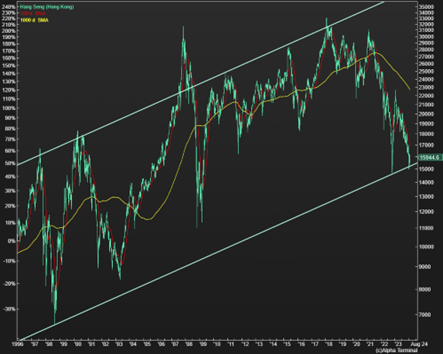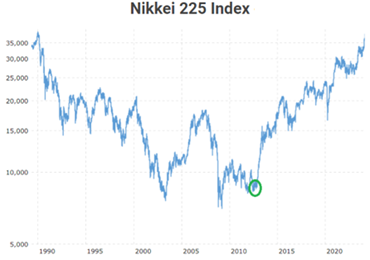Are the Chinese and Hong Kong stock markets ‘investable’?
Recently, there have been a number of articles from various sources, all with the same message – avoid Chinese and Hong Kong equities. These articles have cited that valuations of equities in these regions are ‘very low’ but there is no investor appetite to invest in these and therefore there is no certainty of stock market recoveries.
The articles are correct to highlight the demise of the stock markets in these regions. There are well known reasons as to why this is the case. Valuations are low because there has been a high degree of political unpredictability over the past five years. Investors have not seen a path to a steady environment in which equities can flourish. This has caused the China mainboard exchange to fall as much as 20% since the beginning of 2018, and the Hong Kong market has also fallen close to 50% since the same date.
Trying to pick the exact bottom of markets tends to be a fool’s errand – no one wants to end up with egg on their face proclaiming the bottom is in – so it is easier to stay negative!

However, to my mind, these articles are written with a healthy dose of hindsight and pessimism and less about the future prospects given the already-steep market falls. Peak pessimism is often the time to be considering fishing in troubled waters. Exactly the same sentiment was conveyed regarding supermarkets and ‘big oil’ in 2016 – under the premise that supermarkets will be extinct because we will be shopping only online in 10 years’ time and no one will be consuming oil in the future – fossil fuels will simply not exist. It turns out that 2016 marked close to the lows of the last ten years for supermarkets and big oil and, whilst not providing returns anywhere close to the Magnificent Seven, they have nevertheless provided attractive returns and dividends since their period of peak pessimism.
May Be?
Where to for China and Hong Kong? No one really wants to consider investing in markets that have been falling for over five years unless they have to! However, there are presently two trends worth noting.
Do the charts hold a clue?
Whether you believe in charting or not, the below charts of the Hong Kong stock market and the Chinese Shanghai Stock Exchange (below) since 1996 are overlayed with duplicate trend lines. The trend lines for each market suggest that they are trading close to the bottom trend lines. Markets will always be trying to find something to validate market bottoms and this could be one piece of evidence that is required. When bear markets do ‘turn’, the turn can often be sudden and very strong as buyers rush in.


Lessons from Japan
The Japanese stock market was once considered, and perhaps still is by many, as ‘uninvestable’ – perhaps rightly so, as the Nikkei 225 has only just surpassed its previous high, set in 1989! If you want to put this in context, calculate how old you were then! As may be expected, with such a long ‘bear’ market, Japanese stock market rallies have always been greeted with great scepticism, as for so long they have been nothing but false dawns.
However, in November 2012, foreign investors gained confidence that the new conservative Japanese government, headed by Shinzo Abe (who was shockingly assassinated on 8th July 2022), would reform Japan’s economy. Abe had promised to launch big spending measures and pressure the central bank into more aggressive easing measures to boost the economy. Other measures were introduced to unlock value in public companies. And, as they say, the rest is history – since November 2012 (highlighted in the chart below), Japan’s leading stock market, the Nikkei 225, has beaten the S&P 500, the MSCI All World Index, the German XETRA DAX, the French CAC 40 – and of course, the beleaguered FTSE 100.

What’s the moral of this story? There is generally always a time to buy – even in the most neglected of markets! Investors like government stimulus and low interest rates, but most of all they like reform as it is enduring. Since 2012, profit growth in Japanese companies has surged as shareholders have been placed front and centre – they are now being listened to and a decades-old staid corporate boardroom culture has now been replaced by a highly public results-orientated approach.
Chinese & Hong Kong Stock Markets
Back to China & Hong Kong. The charts show us things are getting interesting. But that is not enough. We have seen plenty of stimulus measures from the Chinese government in 2023. That has not been enough. As with Japan, investors need to see real, tangible measures.
Adam Tooze, of Columbia University, recently wrote a blog citing geopolitical escalation, the chaotic COVID policy, the implosion of the real estate market and now the stock market rout as reasons why China has struggled for foreign investment – to the benefit of other Emerging Markets.
However, he noted China has the economic strength not to worry too much about a slowdown in equity market flows and even foreign investment. It can cope with trade wars and geopolitical uncertainty. But what it does need to worry about are its own middle and upper class – China has vast pools of domestic wealth but increasingly fewer and fewer places to invest it. Domestic investors would consider that there are much better investment opportunities abroad. Capital flight out of the country, as Tooze suggests, is ultimately the real threat to the regime and stability in China.
So, can China withstand yet another year of both falling stock markets and property prices? Politically, this may be unacceptable. Therefore, we may see more significant ‘reform’ in Chinese capital and financial markets in order to incentivise money to stay in China, which would no doubt boost Chinese and Hong Kong stock markets. 2024 could be an interesting year in the Far East!
Risk warning: With investing, your capital is at risk. Opinions constitute our judgement as of this date and are subject to change without warning. Past performance is not a reliable indicator of future results. This article is intended for informational purposes only and no action should be taken or refrained from being taken as a consequence without consulting a suitably qualified and regulated person.
